NVIDIA is launching yet another new member of the GeForce GTX 700 series today, the freshly minted GeForce GTX 760. Like the GeForce GTX 770
which arrived just a few weeks ago, the new GeForce GTX 760 is built
around the company’s GK104 GPU—the very same chip used last year’s
GeForce GTX 680 and a few other GTX 600 series cards. The GeForce GTX
760, however, targets a different market segment and is debuting at a
much more palatable price point than its predecessors.
We’ve got a couple of GeForce GTX 760 cards on hand to show you here, a reference model that came straight from NVIDIA and a fully custom, factory overclocked version from EVGA, the GeForce GTX 760 Super Clocked with ACX cooling. Though, as you’ll see, while the two cards are physically very different, they perform within a few percentage points of one another. Let’s get acquainted with the reference card first and then we’ll move to EVGA’s custom offering and check out all of the performance data...
We’ve got a couple of GeForce GTX 760 cards on hand to show you here, a reference model that came straight from NVIDIA and a fully custom, factory overclocked version from EVGA, the GeForce GTX 760 Super Clocked with ACX cooling. Though, as you’ll see, while the two cards are physically very different, they perform within a few percentage points of one another. Let’s get acquainted with the reference card first and then we’ll move to EVGA’s custom offering and check out all of the performance data...
|
| Graphics Processing Clusters | 3 or 4 |
| Streaming Multiprocessors | 6 |
| CUDA Cores (single precision) | 1152 |
| CUDA Cores (double precision) | -- |
| Texture Units | 96 |
| ROP Units | 32 |
| Base Clock | 980 MHz |
| Boost Clock | 1033 MHz |
| Memory Clock (Data rate) | 6008 MHz |
| L2 Cache Size | 512 KB |
| Total Video Memory | 2048MB GDDR5 |
| Memory Interface | 256-bit |
| Total Memory Bandwidth | 192.26 GB/s |
| Texture Filtering Rate (Bilinear) | 94.1 GigaTexels/sec |
| Fabrication Process | 28 nm |
| Transistor Count | 3.54 Billion |
| Connectors | 2 x Dual-Link DVI 1 x HDMI 1 x DisplayPort |
| Form Factor | Dual Slot |
| Power Connectors | 2 x 6-pin |
| Recommended Power Supply | 500 Watts |
| Thermal Design Power (TDP) | 170 Watts |
| Thermal Threshold | 95°C |
| Currently Selling: | $249 at Amazon |
If you’re a student of the GPU game, the
GeForce GTX 760’s specifications are going to look like somewhat of a
cross between the GeForce GTX 670 and 660 Ti, with some GeForce GTX 700
series features thrown into the mix. If you recall, the GeForce GTX 670
has four Graphics Processing Clusters, with seven SMXes, 1344 CUDA
cores, 112 texture units, and 32 ROPs, with a 256-bit memory interface.
The GTX 660, however, which is powered by GK106, has 3 GPCs, with 960
CUDA cores, 80 texture units, 24 ROPs, and a 192-bit memory interface.
The GeForce GTX 760 has three of four GPCs, with six SMXes, 1152 CUDA
cores, 96 texture units, and 32 ROPS, but retains the 256-bit memory
interface.
In terms of its GPU and memory clock
speeds, the GeForce GTX 760 is right in-line with the GeForce GTX 660.
NVIDIA’s reference specification call for a 980MHz base GPU clock, with a
1033MHz Boost clock and 6008MHz (effective) memory. At those
frequencies, the GTX 760’s texture fillrate is 78.4GT/s with peak memory
bandwidth of 144.2GB/s. Unlike its 600-series predecessors though, the
GeForce GTX 760 supports GPU Boost 2.0, so it should be able to maintain
peak boost clocks longer.
Like its predecessors, however, the
reference GeForce GTX 760 also has a short PCB design. NVIDIA moved the
power delivery circuitry to the “west” end of the PCB and rotated the
GPU to minimize necessary real-estate, which allowed them to shave a few
inches off the reference board. Although cards are 9.5” long due to the
cooler design, the actual PCB is less than 7” in length. Although, we
should point out that some board partners have opted to use longer PCBs,
as you’ll see on the next page.
The TDP of the GeForce GTX 760 is 170 watts, and a pair of 6-pin supplemental power feeds are necessary. Outputs on the GeForce GTX 760 consist of a pair of DVI ports, a mini-DP, and an HDMI output. The GeForce GTX 760 has enough muscle to push multiple displays simultaneously, and as such, it supports NVIDIA's 3D Vision Surround technology, as well other proprietary NVIDA technologies like 3DVision, PhyX, and the like.
The TDP of the GeForce GTX 760 is 170 watts, and a pair of 6-pin supplemental power feeds are necessary. Outputs on the GeForce GTX 760 consist of a pair of DVI ports, a mini-DP, and an HDMI output. The GeForce GTX 760 has enough muscle to push multiple displays simultaneously, and as such, it supports NVIDIA's 3D Vision Surround technology, as well other proprietary NVIDA technologies like 3DVision, PhyX, and the like.
The EVGA GeForce GTX 760 SuperClocked
with ACX cooling’s main differentiators are its custom heatsink and fan
assembly and longer PCB.
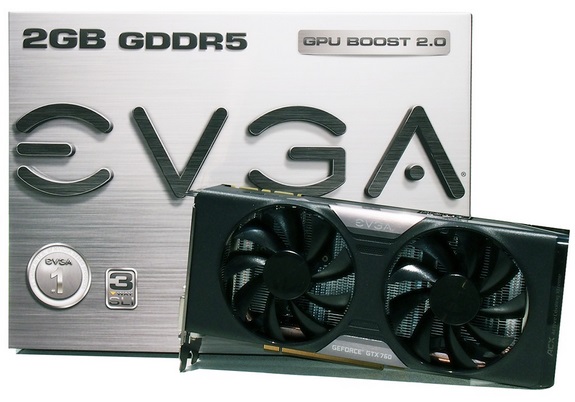
The dual-fan Active Cooling Extreme, or ACX, cooler features a large heatsink array, with 40% additional fin volume over reference designs. If you look close, you’ll notice that there are actually two heatsinks, one that sits right atop the GPU and another just to the right, and that the heatsinks are linked to the baseplate by multiple thick heatpipes. There is an additional heatplate mounted to the PCB as well, which adds strength and helps keep the PCB flat.
The fans used on the ACX cooler also received some special treatment. According to EVGA the fan blade design is more durable than standard fans and the dual-ball bearings offer increased longevity over more common sleeve bearings.
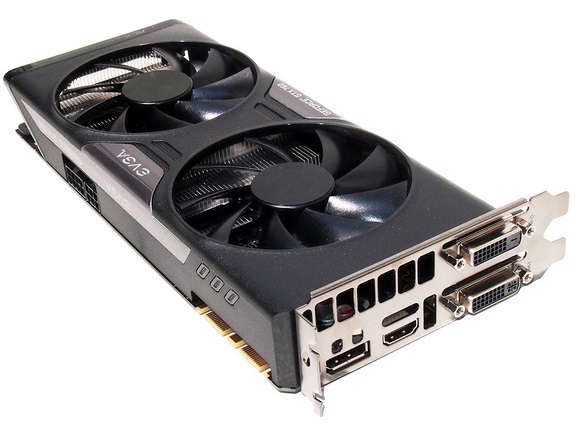
All told, EVGA claims the ACX cooler outperforms reference coolers, while reducing weight and thickness, and it should be quieter and last longer too. With the GTX 760 and its GPU Boost 2.0 feature, however, the card may still ramp up to whatever target temperature is specified in the driver, by dynamically boosting and adjusting the GPU frequency and voltage as necessary based on the workload. That means the ACX cooler may not necessarily always offer lower temperatures than a reference cooler, but it should allow the card to idle at lower temps and remain at max boost for longer periods, which should ultimately increase overall performance.
The EVGA GeForce GTX 760 SuperClocked with ACX cooling is a dual-slot card, but it is slightly thinner than the reference model. As the “SuperClocked” in the name suggests, this card is factory overclocked. Whereas reference GeForce GTX 760 cards sport 980MHz / 1033MHz GPU base and boost clocks, respectively, the EVGA GeForce GTX 760 SuperClocked with ACX cooling come in at 1072MHz (base) / 1137MHz (boost). All of the other specifications, including the 2GB of GDDR5 memory clocked at an effective 6008 MHz, remain unchanged from the reference model.
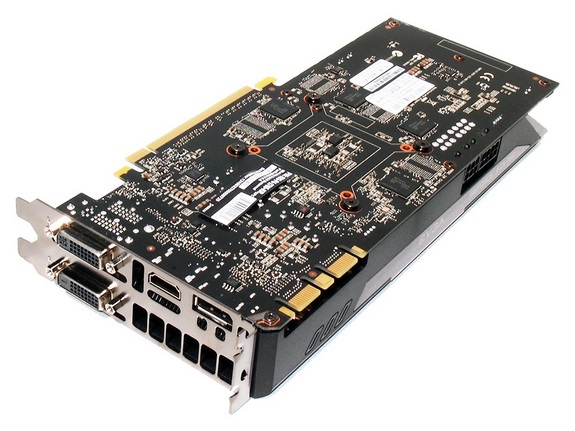
As evidenced by the pair of SLI edge connectors at the top of the card, the EVGA GeForce GTX 760 SC with ACX supports up to 3-Way SLI, and because the TDP of the card is only 170 watts, dual 6-pin supplemental PCI Express power feeds are all that are required to power it. Outputs consist of a pair of dual-link DVI outputs, a full-sized DisplayPort output, and an HDMI connector.
In typical EVGA fashion, plenty of goodies are bundled with the GeForce GTX 760 SC w/ ACX as well. Included with the card, we found a rather cool “Game of Pwns” poster, some large “Enthusiast Built” decals, various documentation, a driver / utility CD (which included EVGA excellent Precision X utility), and a few adapters—two dual-peripheral to 6-pin adapters and a VGA-to-DVI adapter. There were no games to speak off, but EVGA wasn’t exactly chintzy with the bundle either.
The dual-fan Active Cooling Extreme, or ACX, cooler features a large heatsink array, with 40% additional fin volume over reference designs. If you look close, you’ll notice that there are actually two heatsinks, one that sits right atop the GPU and another just to the right, and that the heatsinks are linked to the baseplate by multiple thick heatpipes. There is an additional heatplate mounted to the PCB as well, which adds strength and helps keep the PCB flat.
The fans used on the ACX cooler also received some special treatment. According to EVGA the fan blade design is more durable than standard fans and the dual-ball bearings offer increased longevity over more common sleeve bearings.
All told, EVGA claims the ACX cooler outperforms reference coolers, while reducing weight and thickness, and it should be quieter and last longer too. With the GTX 760 and its GPU Boost 2.0 feature, however, the card may still ramp up to whatever target temperature is specified in the driver, by dynamically boosting and adjusting the GPU frequency and voltage as necessary based on the workload. That means the ACX cooler may not necessarily always offer lower temperatures than a reference cooler, but it should allow the card to idle at lower temps and remain at max boost for longer periods, which should ultimately increase overall performance.
The EVGA GeForce GTX 760 SuperClocked with ACX cooling is a dual-slot card, but it is slightly thinner than the reference model. As the “SuperClocked” in the name suggests, this card is factory overclocked. Whereas reference GeForce GTX 760 cards sport 980MHz / 1033MHz GPU base and boost clocks, respectively, the EVGA GeForce GTX 760 SuperClocked with ACX cooling come in at 1072MHz (base) / 1137MHz (boost). All of the other specifications, including the 2GB of GDDR5 memory clocked at an effective 6008 MHz, remain unchanged from the reference model.
As evidenced by the pair of SLI edge connectors at the top of the card, the EVGA GeForce GTX 760 SC with ACX supports up to 3-Way SLI, and because the TDP of the card is only 170 watts, dual 6-pin supplemental PCI Express power feeds are all that are required to power it. Outputs consist of a pair of dual-link DVI outputs, a full-sized DisplayPort output, and an HDMI connector.
In typical EVGA fashion, plenty of goodies are bundled with the GeForce GTX 760 SC w/ ACX as well. Included with the card, we found a rather cool “Game of Pwns” poster, some large “Enthusiast Built” decals, various documentation, a driver / utility CD (which included EVGA excellent Precision X utility), and a few adapters—two dual-peripheral to 6-pin adapters and a VGA-to-DVI adapter. There were no games to speak off, but EVGA wasn’t exactly chintzy with the bundle either.
How We Configured Our Test Systems: We tested the graphics cards in this article on an Asus P9X79 Deluxe motherboard
powered by a Core i7-3960X six-core processor and 16GB of G.SKILL
DDR3-1866 RAM. The first thing we did when configuring the test system
was enter the system UEFI and set all values to their "high performance"
default settings and disable any integrated peripherals that wouldn't
be put to use. The memory's X.M.P. profile was enabled to ensure
better-than-stock performance and the hard drive was then formatted and
Windows 7 Ultimate x64 was installed. When the installation was
complete, we fully updated the OS and installed the latest DirectX
redist along with all of the drivers, games, and benchmark tools
necessary to complete our tests.


The new GeForce GTX 760 finished right about where you'd expect it to in the Heaven Benchmark. The 760 outran the GeForce GTX 660 Ti and Radeon HD 7950, but trailed the GeForce GTX 770. Thanks to its higher clocks, EVGA's offering came out ahead of the reference design by few percentage points.
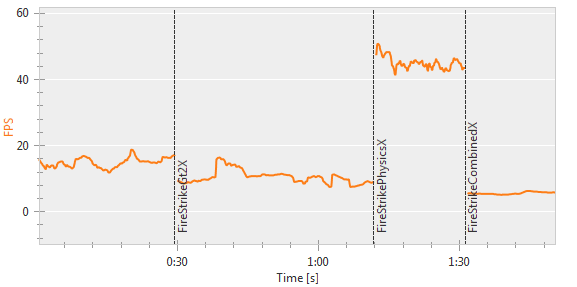 Reference GeForce GTX 760 3DMark Fire Strike Run
Reference GeForce GTX 760 3DMark Fire Strike Run
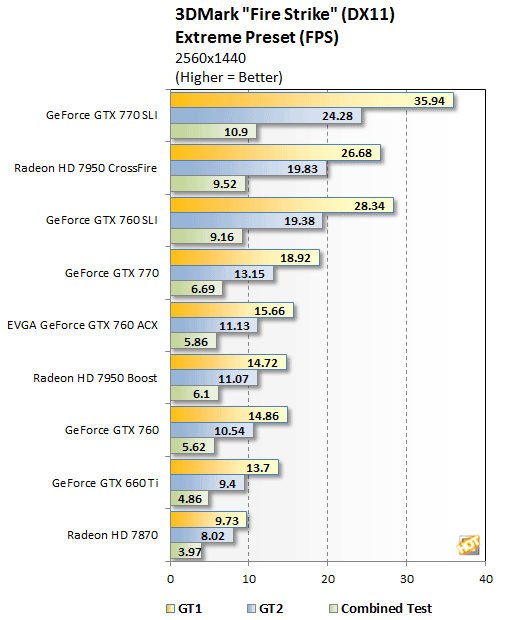

3DMark Fire Strike tells a somewhat different story then Unigine Heaven. Both of the GeForce GTX 760 cards we tested outperformed the GeForce GTX 660 Ti and trailed the GeForce GTX 770, but in this benchmark the Radeon HD 7950 was a tad faster than the 760.
|
| Hardware Used: Intel Core i7-3960X (3.3GHz, Six-Core) Asus P9X79 Deluxe (Intel X79 Express) Radeon HD 7870 GHz Edition Radeon HD 7950 Boost x 2 GeForce GTX 760 x 2 EVGA GeForce GTX 760 SC w/ ACX GeForce GTX 660 Ti GeForce GTX 770 x 2 16GB GSKILL DDR3-1866 Western Digital Raptor 150GB Integrated Audio Integrated Network |
Relevant Software: Windows 7 Ultimate x64 DirectX April 2011 Redist AMD Catalyst v13.6B2 NVIDIA GeForce Drivers v320.39 Benchmarks Used: Unigine Heaven v4 3DMark "Fire Strike" Bioshock Infinite Hitman: Absolution Alien vs. Predator Metro Last Light Sleeping Dogs Crysis 3 FRAPS + FCAT |
|
 Unigine Heaven v4.0
Unigine Heaven v4.0 |
Unigine's Heaven Benchmark v4.0 is built around the Unigine game engine. Unigine is a cross-platform, real-time 3D engine, with support for DirectX 9, DirectX 10, DirectX 11 and OpenGL. The Heaven benchmark--when run in DX11 mode--also makes comprehensive use of tessellation technology and advanced SSAO (screen-space ambient occlusion). It also features volumetric cumulonimbus clouds generated by a physically accurate algorithm and a dynamic sky with light scattering. |


The new GeForce GTX 760 finished right about where you'd expect it to in the Heaven Benchmark. The 760 outran the GeForce GTX 660 Ti and Radeon HD 7950, but trailed the GeForce GTX 770. Thanks to its higher clocks, EVGA's offering came out ahead of the reference design by few percentage points.
|
 Futuremark 3DMark Fire Strike |
Fire Strike has two benchmark modes: Normal mode runs in 1920x1080, while Extreme mode targets 2560x1440. GPU target frame buffer utilization for normal mode is 1GB and the benchmark uses tessellation, ambient occlusion, volume illumination, and a medium-quality depth of field filter. The more taxing Extreme mode targets 1.5GB of frame buffer memory and increases detail levels across the board. Extreme mode is explicitly designed for CrossFire / SLI systems. GT 1 focuses on geometry and illumination, with over 100 shadow casting spot lights, 140 non-shadow casting point lights, and 3.9 million vertices calculated for tessellation per frame. And 80 million pixels are processed per frame. GT2 emphasizes particles and GPU simulations. Tessellation volume is reduced to 2.6 million vertices and the number of pixels processed per frame rises to 170 million. |
 Reference GeForce GTX 760 3DMark Fire Strike Run
Reference GeForce GTX 760 3DMark Fire Strike Run

3DMark Fire Strike tells a somewhat different story then Unigine Heaven. Both of the GeForce GTX 760 cards we tested outperformed the GeForce GTX 660 Ti and trailed the GeForce GTX 770, but in this benchmark the Radeon HD 7950 was a tad faster than the 760.
We also spent a little time overclocking
the GeForce GTX 760 to see what kind of additional frequency headroom
it had left under its hood. For these tests, we used the latest edition
of EVGA's Precision X GPU tweaking utility, which is designed to work
with NVIDIA's GeForce GTX 700 series products.
Overclocking a Kepler-based GeForce GTX series graphics card requires a bit more tweaking then previous-gen products, due to all of the new options available and the complexities associated with GPU Boost 2.0. Sometimes, you’ll find that increasing a particular voltage or frequency may appear to function properly, when in fact performance decreases due to errors or throttling. You may also find that the actual GPU Boost clock may travel above or below the designated offset value when the power and/or temperature targets are also increased.

EVGA's Precision X Tweaking Utility Running On The GeForce GTX 760
We did a few things when experimenting with overclocked speeds on the GTX 770. First we tried the most basic option available--we simply changed the temperature target from the default 80'C and increased it to 94'C to see what kind of impact it would have on performance. Then, to push things much further, we increased the power and temperature targets to 115% and 94'C, respectively, and also increased the GPU and Memory clock offsets and ran a few tests. Unfortunately, due to time constraints, we didn't overclock both of the GeForce GTX 760 cards we had on hand, and focused solely on EVGA's SC w/ ACX model.
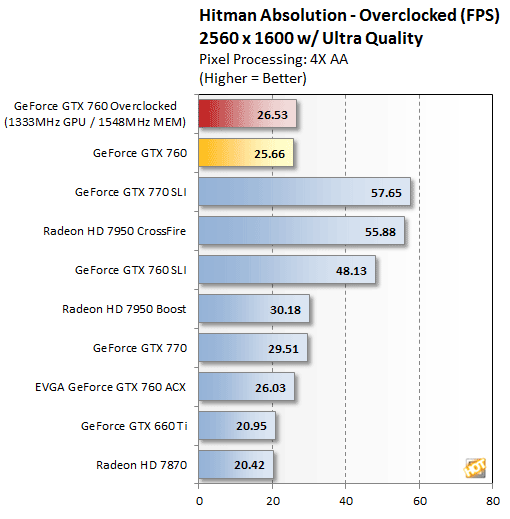
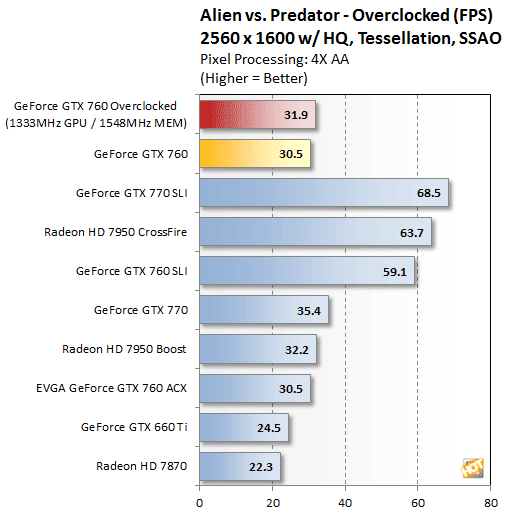
Ultimately, we were able to take the EVGA GeForce GTX 760 SC w/ ACX cooling all the way up to a 1333MHz GPU clock with 1548MHz memory (6192MHz effective). Those are some major increases in frequency over the stock 1033MHz (GPU) and 6088MHz (memory) frequencies called for in NVIDIA's spec.
Overclocking a Kepler-based GeForce GTX series graphics card requires a bit more tweaking then previous-gen products, due to all of the new options available and the complexities associated with GPU Boost 2.0. Sometimes, you’ll find that increasing a particular voltage or frequency may appear to function properly, when in fact performance decreases due to errors or throttling. You may also find that the actual GPU Boost clock may travel above or below the designated offset value when the power and/or temperature targets are also increased.

EVGA's Precision X Tweaking Utility Running On The GeForce GTX 760
We did a few things when experimenting with overclocked speeds on the GTX 770. First we tried the most basic option available--we simply changed the temperature target from the default 80'C and increased it to 94'C to see what kind of impact it would have on performance. Then, to push things much further, we increased the power and temperature targets to 115% and 94'C, respectively, and also increased the GPU and Memory clock offsets and ran a few tests. Unfortunately, due to time constraints, we didn't overclock both of the GeForce GTX 760 cards we had on hand, and focused solely on EVGA's SC w/ ACX model.
|


Ultimately, we were able to take the EVGA GeForce GTX 760 SC w/ ACX cooling all the way up to a 1333MHz GPU clock with 1548MHz memory (6192MHz effective). Those are some major increases in frequency over the stock 1033MHz (GPU) and 6088MHz (memory) frequencies called for in NVIDIA's spec.
Before bringing this article to a close, we'd like to cover a few final
data points--namely, power consumption, temperatures, and noise.
Throughout all of our benchmarking and testing, we monitored acoustics
and tracked how much power our test system was consuming using a power
meter. Our goal was to give you an idea of how much power each
configuration used while idling and also while under a heavy workload.
Please keep in mind that we were testing total system power consumption
at the outlet here, not just the power being drawn by the graphics cards
alone.

The GeForce GTX 760's power consumption fell right in-line with expectations. All of the cards consumed similar power while idling at the Windows Desktop, but under load, the GeForce GTX 760's power consumption fell somewhere in between the GeForce GTX 660 Ti and Radeon HD 7950.

Temperatures and noise are non-issues with the GeForce GTX 760. Like other cards with GPU Boost 2.0, the GeForce GTX 760's GPU temperature will peak at whatever temperature is set in driver--in this case 80'C. And though the card's fan does spin up under load, it never gets anywhere near what we'd consider noisy. The EVGA GeForce GTX 760 SC w/ ACX cooling, however, clearly offered better cooling performance than NVIDIA's reference model, and it remained quiet throughout testing as well.
|

The GeForce GTX 760's power consumption fell right in-line with expectations. All of the cards consumed similar power while idling at the Windows Desktop, but under load, the GeForce GTX 760's power consumption fell somewhere in between the GeForce GTX 660 Ti and Radeon HD 7950.

Temperatures and noise are non-issues with the GeForce GTX 760. Like other cards with GPU Boost 2.0, the GeForce GTX 760's GPU temperature will peak at whatever temperature is set in driver--in this case 80'C. And though the card's fan does spin up under load, it never gets anywhere near what we'd consider noisy. The EVGA GeForce GTX 760 SC w/ ACX cooling, however, clearly offered better cooling performance than NVIDIA's reference model, and it remained quiet throughout testing as well.
Performance Summary: The
new GeForce GTX 760 performed well throughout our entire battery of
tests, especially considering its relatively mainstream price point. As
its model number suggests, the GeForce GTX 760 offers better overall
performance than the GeForce GTX 660 / 660 Ti it is supplanting in
NVIDIA’s product stack, though it can’t keep pace with the more powerful
GeForce GTX 770. Versus AMD’s current offerings, the GeForce GTX 760
clearly outperforms the Radeon HD 7870 GHz Edition and it can easily
hang with and occasionally outperform the Radeon HD 7950 Boost.
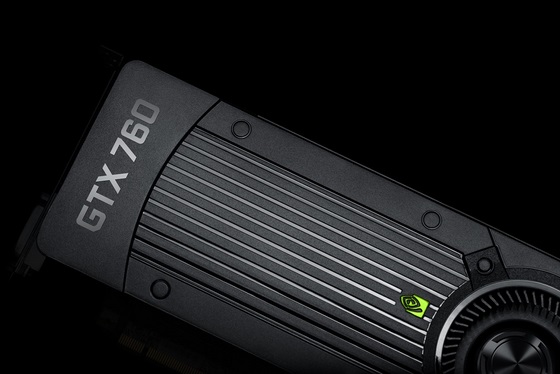
The GeForce GTX 760
 According
to NVIDIA, the GeForce GTX 760 will be the last update to their desktop
graphics card line-up for a while. We suspect new products may hit for
the holidays or in the CES 2014 time frame, but for now and through the
fall, NVIDIA’s graphics card line-up looks like this:
According
to NVIDIA, the GeForce GTX 760 will be the last update to their desktop
graphics card line-up for a while. We suspect new products may hit for
the holidays or in the CES 2014 time frame, but for now and through the
fall, NVIDIA’s graphics card line-up looks like this:
The GeForce GTX 660 Ti will be going away in favor of the GTX 760, though the lower-end GeForce GTX 600 series cards will remain.
With an expected starting price point of $249, the GeForce GTX 760 targets the “sweet spot” of the PC graphics market and it does so quite well. At that price, the GeForce GTX 760 is more affordable than the GTX 660 Ti and the Radeon HD 7950, though AMD is offering some excellent games as part of their “Never Settle Reloaded” bundle that sweeten the deal. With that said, NVIDIA has still raised the bar in terms of performance per dollar, which is what we think most gamers consider when upgrading or purchasing a new graphics card. It doesn’t’ feature any whiz-bang new technology and leverages last year’s flagship GPU, but the GeForce GTX 760’s represents a good value for gamers looking for the best bang for their buck.


The GeForce GTX 760
The GeForce GTX 660 Ti will be going away in favor of the GTX 760, though the lower-end GeForce GTX 600 series cards will remain.
With an expected starting price point of $249, the GeForce GTX 760 targets the “sweet spot” of the PC graphics market and it does so quite well. At that price, the GeForce GTX 760 is more affordable than the GTX 660 Ti and the Radeon HD 7950, though AMD is offering some excellent games as part of their “Never Settle Reloaded” bundle that sweeten the deal. With that said, NVIDIA has still raised the bar in terms of performance per dollar, which is what we think most gamers consider when upgrading or purchasing a new graphics card. It doesn’t’ feature any whiz-bang new technology and leverages last year’s flagship GPU, but the GeForce GTX 760’s represents a good value for gamers looking for the best bang for their buck.

|
|
READ MORE : http://hothardware.com
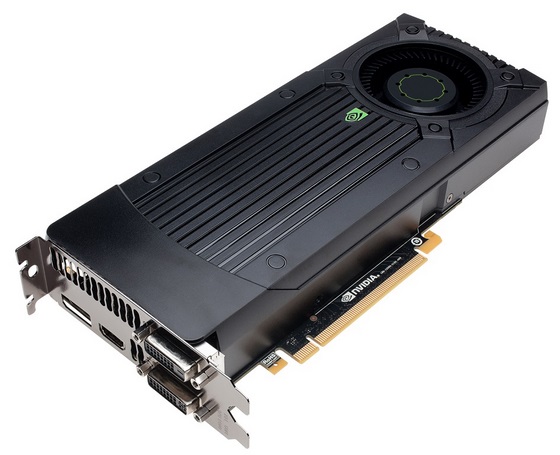
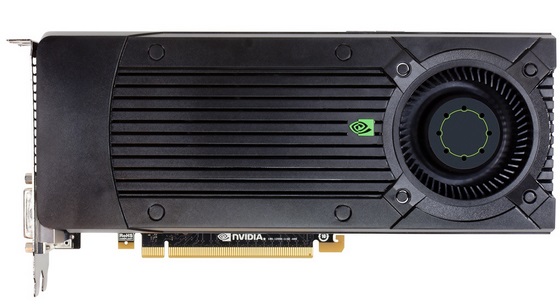
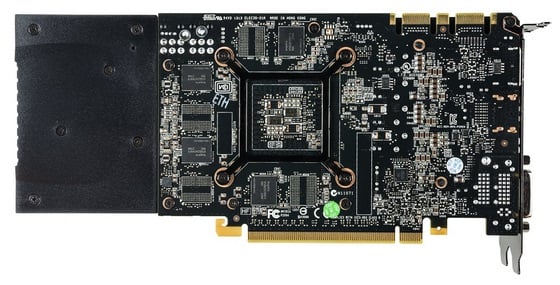
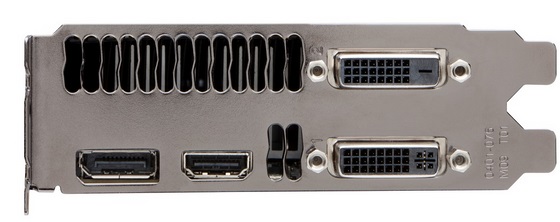
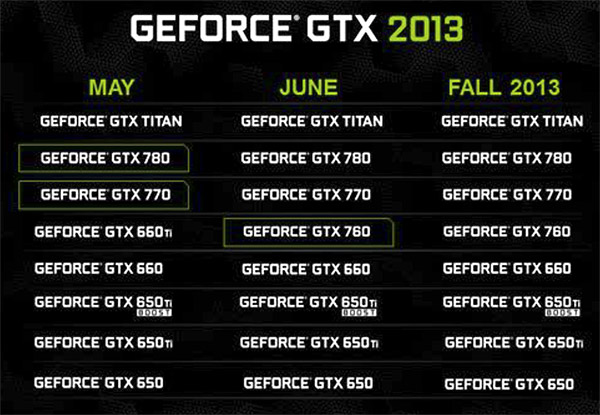

Tidak ada komentar:
Posting Komentar